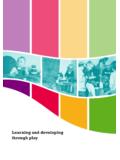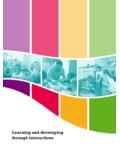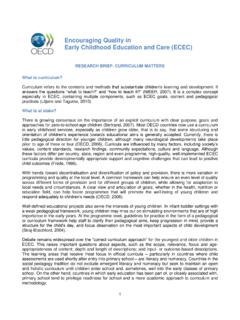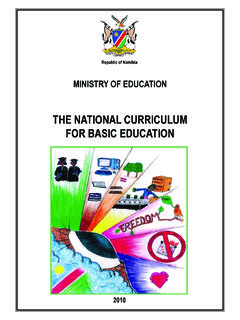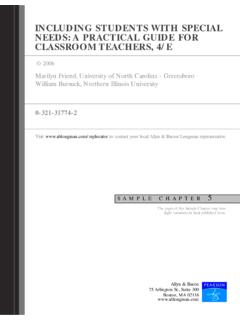Transcription of User guide - ncca.biz
1 user guide NCCA 2009 National Council for curriculum and Assessment 24 Merrion Square, Dublin 2. 3 Aistear: the Early Childhood curriculum Framework ContentsAistear: the Early Childhood curriculum Framework 4 What is Aistear and what s its purpose? 4 What is in Aistear? 4 How are the themes structured? 5 How are the themes presented? 6 How are the guidelines structured? 6 Are there important terms to remember in Aistear? 6 Where can I find out about the research that supports Aistear? 6 How was the early childhood sector involved in developing Aistear? 7 Were children involved in developing Aistear? 7 What knowledge, dispositions, skills, and abilities can help me to use Aistear? 7 Linking Aistear with other developments 8 Can Aistear be used with other curriculum materials?
2 9 Can Aistear be used with the Primary School curriculum ? 9 Can Aistear and S olta be used together? 9 Does Aistear connect with the revised Child Care (Pre-School Services) Regulations (2006)? 9 How can Aistear connect with the Workforce Development Plan? 9 Using Aistear in different types of settings 11 How can planning help me to use Aistear? 12 What are long-term plans? 13 What are medium-term plans? 13 What are short-term plans? 13 What is an Individual Education Plan? 13 What are daily or activity plans? 14 Sample plans 14 Sample plan 1: Childminder s daily plan 15 Sample plan 2: Activity plan for full daycare setting 16 Sample plan 3a: Daily plan for primary school 17 Sample plan 3b: Individual Education Plan 19 Sample plan 4: Activity plan for sessional setting 22 Conclusion 22 Appendix 1 23 TablesTable 1: Principles of Aistear, the Primary School curriculum and S olta 10 Figures Figure 1: Describing children s learning and development through themes 5 Figure 2: Aistear supporting other developments 84 user guideAistear: the Early Childhood curriculum Framework Aistear: the Early Childhood curriculum Framework The development of Aistear.
3 The Early Childhood curriculum Framework marks an exciting milestone in early childhood education and care in Ireland. Aistear builds on and supports many other important developments for children under six years (see Appendix 1). This user guide outlines Aistear s contents and shows how you might use these to provide enriching learning experiences for children. The guide also answers some frequently asked questions about Aistear and gives some ideas on how to plan your work when using Aistear, S olta and the Primary School is Aistear and what s its purpose?Aistear is Ireland s curriculum framework for children from birth to six years. It contains information for parents and practitioners that will help them plan for and provide challenging and enjoyable learning experiences that can enable all children to grow and develop as competent and confident learners in the context of loving relationships with others.
4 Aistear describes the types of learning and development that are important for children in their early years, and offers ideas and suggestions on how these might be nurtured. Aistear can be used in a range of settings, including children s own homes, childminding settings, cr ches, playgroups, pre-schools, na onra , and infant classes in primary and special schools. What is in Aistear?Aistear is based on 12 broad early childhood principles. Each principle is presented using a short theoretical statement, which is then explained from the child s perspective. Aistear uses four themes that connect and overlap with each other to outline children s learning and development. The themes areWell-being Identity and Belonging Communicating Exploring and Thinking.
5 Guidelines offer you support in using Aistear s principles and themes in your work with children. These guidelines describe good practice inbuilding partnerships between parents and practitioners learning and developing through interactions learning and developing through play supporting learning and development through assessment. 5 user guideAistear: the Early Childhood curriculum Framework How are the themes structured?Each theme includes aims and broad learning goals for all children from birth to six years (see Figure 1). The aims and goals outline the dispositions, attitudes and values, skills, knowledge, and understanding that the adult nurtures in children to help them learn and develop.
6 Figure 1: Describing children s learning and development through themesEach theme has a set of sample learning opportunities. These give you ideas about the many different types of experiences you might provide for children to help them learn and develop across Aistear s aims and learning goals. The sample learning opportunities are, therefore, suggestions. You can adapt and extend them to suit the children in your setting. The sample learning opportunities are presented for three overlapping age groups:babies: birth to 18 months toddlers: 12 months to 3 years young children: 2 to 6 years. 6 user guideAistear: the Early Childhood curriculum Framework Some of the sample learning opportunities suggested can be adapted for use with the three age groups, while others are more suitable to one particular age group or stage of development.
7 In addition, some learning opportunities are more suited to children at home or in a childminding setting, while others are more useful in a group or school setting. How are the themes presented?The themes are colour coded:PurPle is used for Well-beingred is used for Identity and BelongingYellow is used for Communicating Green is used for Exploring and Thinking. How are the guidelines structured?Each set of guidelines describes good practice and includes learning experiences and reflection questions. The learning experiences are detailed accounts of children learning through particular activities or events, in collaboration with other children and adults, while using various objects, play props or materials.
8 They describe what the children say, do and make in the course of the activities or events. They also show the adult s important role in supporting and extending the children s learning and development. Some of the experiences include misspellings and/or mispronunciations which reflect the children s attempts at spelling and pronunciation. The correct spelling is included in brackets to clarify what the children say or write. In the English version of Aistear where a learning experience is described in an Irish-medium setting the learning experience is translated and presented before the English version. Many of the learning experiences include comments and/or short conversations between adults and children and between children and children.
9 Aistear uses two distinct fonts in jade green to highlight these contributions by the children and adults. The learning experiences on the CD and online are searchable by:age group (babies, toddlers, young children) setting type (home, childminding, full and part-time daycare, sessional service, infant class in primary school) theme (Well-being, Identity and Belonging, Communicating, Exploring and Thinking).Like the four themes, the learning experiences are colour coded to reflect the particular theme in question. Are there important terms to remember in Aistear?Aistear uses the term parents to refer to the child s primary caregivers and educators. These include the child s father and mother and/or guardians.
10 The term practitioner refers to all those working in a specialised manner with children in all early childhood settings. It includes childminders and teachers working in infant classes in primary schools. The term adult refers to both parents and practitioners. At times, however, some information may be more relevant to a practitioner than to parents. In the learning experiences terms like childminder, pre-school leader and teacher are used to reflect the different types of setting in which the experiences are set. Also in the learning experiences terms like mammy, mam, ma, mom, mum, daddy, dad and da, granny, nanny, gran, grandad, granpa, and granda are used to reflect the different words children in Ireland use to refer to their parents and grandparents.
